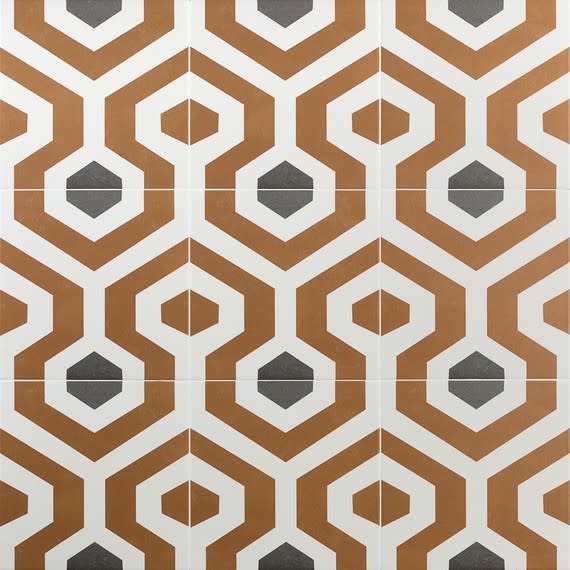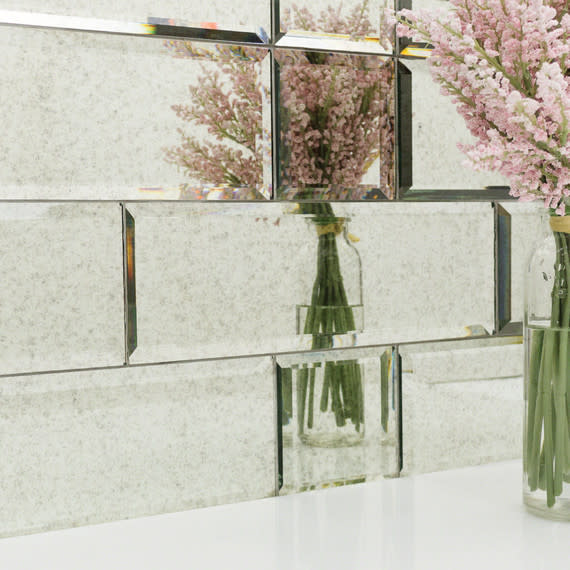Your Guide to Choosing the Right Tile for Your Space

When it comes to home renovations, the details are what really make a place shine. A statement tile can bring that "wow" factor to a room. But how do you go about choosing the right one? There are a lot of different options on the market, and each one comes with pros and cons. Read on to learn about some of the most popular types of tile, plus tips for choosing the right one for your space.
Related: 6 Gorgeous Tile Design Ideas
Pick the Right Tile for Your Project
Because tiles are made from such different materials and in unique processes, it's important to know which kinds are best for various areas of the home. While porcelain products can be placed almost anywhere, Nancy Epstein, CEO of Artistic Tile, explains that certain stones react poorly with water. For instance, a dark-colored limestone wouldn't be a good choice for a shower since it will show all the calcium in the water. "On a floor that's just getting washed, it's fine. But in a shower, with constant exposure to water, the veins can open up," she says.
Work with a Knowledgeable Installer
Interior designer Alena Capra, a spokesperson for tile expo Coverings, says that certified installers are required for specialty materials, like stone. The Ceramic Tile Education Foundation recommends using an installer that is a Certified Tile Installer (CTI). You can search for certified installers using this tool. Any installer you hire should have a minimum of two years of experience in laying tile, not just assisting.
Understand Your Budget
Choosing and installing tile is an investment, but some options are more affordable than others. In general, porcelain will be the most affordable type of tile since it's mechanically made and made in larger quantities. There are also lower-priced options for ceramic and stone tiles. As Epstein points out: "Usually, the installation costs more than the product itself. So, you may as well install what you love."

Ceramic
Ceramic tiles are classic. In fact, Epstein says that ceramic tile was really the only type of flooring tile on the market until roughly 25 years ago. Made from clay and baked at high temperatures, these tiles date back centuries and can be found throughout ancient ruins all over the world. "These days, the 'body' of the tile is often made up of other natural materials, depending on the type of clay used," says Pace Tropper, Vice President of Marketing at TileBar. This is an extremely common practice and is done in order to improve the quality of the tile. For example, feldspar is a common additive, which aids in durability and resistance to chemical corrosion. The fact that they can be used in any area of the home (but are most commonly used in wet areas like kitchens and bathrooms) is what makes ceramic tile such a popular choice.
As a bonus, the material is extremely durable and easy to care for. "One of the most popular styles of ceramic that can be found is subway tile," says Tropper. "This style is a traditional favorite thanks to its rectangular shape and ability to be laid in multiple options, giving it an essence of individuality." The reasonable cost of these tiles also makes it popular: On average, materials and installation range between $3 and $7 per square foot.
Related: The Best Way to Clean and Brighten Grout and Tile

Porcelain
Porcelain tiles, also loved for their durability, are made from a clay that is baked at a very high temperature and then given a glaze, Topper explains. The glaze seals the tile, making it water resistant. For that reason, porcelain tiles are an ideal option for bathrooms or a kitchen backsplash, but just like ceramic tile, porcelain can be used in almost any area of the home. The drawback of porcelain tile, Epstein explains, is the lack of originality in design. Porcelain tile is machine-made, and though the technology has come a long way, will never quite measure up to artisan tiles in terms of design. On average, porcelain tile can cost between $3-$10 per square foot, making it one of the more affordable options.

Stone
Natural stones—such as marble, limestone, granite, and sandstone—will give your home a luxurious look, and these materials only get better as they patina. The differences in stone is in the porosity. "If you want to classify really broadly, you could say, 'Granites are usually denser than marbles, which are usually denser than limestones,'" Epstein says. "But with the sealers that have been developed in the last 20 years, normally you don't have to worry about any of it." And, as Tropper adds, "Natural stones can be polished or matte, and makes a superior option as a large format tile." With all that beauty comes a hefty price tag. For material alone, stone tile runs from $5-$10 per square foot, with an additional $7 per square foot for installation costs.

Glass
Glass is a versatile option and can be used both indoors and outdoors. "While it may seem like a more basic tile, it is quite the opposite," says Tropper. "Glass tile can be found in many shapes from mosaics to subway tile." It's available in a variety of finishes, from frosty and opaque to ultra-reflective, and can even be useful in making small spaces appear bigger. Capra says that maintenance of glass tile is fairly easy—if it's not grouted, it can be cleaned simply with window cleaner and a cloth. The only thing you may have to worry about, she adds, is something hitting and cracking it, which means it's not a great choice around rambunctious children or pets. The average cost of glass tile (materials and installation) is $9, placing it on the pricier side.

